Alexander Porfyrovych Archipenko (also referred to as Olexandr, Oleksandr, or Aleksandr/ Ukranian: Олександр Порфирович Архипенко) (1887 – 1964)
Get a Alexander Porfyrovych Archipenko (also referred to as Olexandr, Oleksandr, or Aleksandr/ Ukranian: Олександр Порфирович Архипенко) (1887 – 1964) Certificate of Authenticity for your painting (COA) for your Alexander Porfyrovych Archipenko (also referred to as Olexandr, Oleksandr, or Aleksandr/ Ukranian: Олександр Порфирович Архипенко) (1887 – 1964) drawing.
For all your Alexander Porfyrovych Archipenko (also referred to as Olexandr, Oleksandr, or Aleksandr/ Ukranian: Олександр Порфирович Архипенко) (1887 – 1964) artworks you need a Certificate of Authenticity (COA) in order to sell, to insure or to donate for a tax deduction.
Getting a Alexander Porfyrovych Archipenko (also referred to as Olexandr, Oleksandr, or Aleksandr/ Ukranian: Олександр Порфирович Архипенко) (1887 – 1964) Certificate of Authenticity (COA) is easy. Just send us photos and dimensions and tell us what you know about the origin or history of your Alexander Porfyrovych Archipenko (also referred to as Olexandr, Oleksandr, or Aleksandr/ Ukranian: Олександр Порфирович Архипенко) (1887 – 1964) painting or drawing.
If you want to sell your Alexander Porfyrovych Archipenko (also referred to as Olexandr, Oleksandr, or Aleksandr/ Ukranian: Олександр Порфирович Архипенко) (1887 – 1964) painting or drawing use our selling services. We offer Alexander Porfyrovych Archipenko (also referred to as Olexandr, Oleksandr, or Aleksandr/ Ukranian: Олександр Порфирович Архипенко) (1887 – 1964) selling help, selling advice, private treaty sales and full brokerage.
We have been authenticating Alexander Porfyrovych Archipenko (also referred to as Olexandr, Oleksandr, or Aleksandr/ Ukranian: Олександр Порфирович Архипенко) (1887 – 1964) and issuing certificates of authenticity since 2002. We are recognized Alexander Porfyrovych Archipenko (also referred to as Olexandr, Oleksandr, or Aleksandr/ Ukranian: Олександр Порфирович Архипенко) (1887 – 1964) experts and Alexander Porfyrovych Archipenko (also referred to as Olexandr, Oleksandr, or Aleksandr/ Ukranian: Олександр Порфирович Архипенко) (1887 – 1964) certified appraisers. We issue COAs and appraisals for all Alexander Porfyrovych Archipenko (also referred to as Olexandr, Oleksandr, or Aleksandr/ Ukranian: Олександр Порфирович Архипенко) (1887 – 1964) artworks.
Our Alexander Porfyrovych Archipenko (also referred to as Olexandr, Oleksandr, or Aleksandr/ Ukranian: Олександр Порфирович Архипенко) (1887 – 1964) paintings and drawings authentications are accepted and respected worldwide.
Each COA is backed by in-depth research and analysis authentication reports.
The Alexander Porfyrovych Archipenko (also referred to as Olexandr, Oleksandr, or Aleksandr/ Ukranian: Олександр Порфирович Архипенко) (1887 – 1964) certificates of authenticity we issue are based on solid, reliable and fully referenced art investigations, authentication research, analytical work and forensic studies.
We are available to examine your Alexander Porfyrovych Archipenko (also referred to as Olexandr, Oleksandr, or Aleksandr/ Ukranian: Олександр Порфирович Архипенко) (1887 – 1964) painting or drawing anywhere in the world.
You will generally receive your certificates of authenticity and authentication report within two weeks. Some complicated cases with difficult to research Alexander Porfyrovych Archipenko (also referred to as Olexandr, Oleksandr, or Aleksandr/ Ukranian: Олександр Порфирович Архипенко) (1887 – 1964) paintings or drawings take longer.
Our clients include Alexander Porfyrovych Archipenko (also referred to as Olexandr, Oleksandr, or Aleksandr/ Ukranian: Олександр Порфирович Архипенко) (1887 – 1964) collectors, investors, tax authorities, insurance adjusters, appraisers, valuers, auctioneers, Federal agencies and many law firms.
We perform Alexander Porfyrovych Archipenko art authentication, appraisal, certificates of authenticity (COA), analysis, research, scientific tests, full art authentications. We will help you sell your Alexander Porfyrovych Archipenko or we will sell it for you.
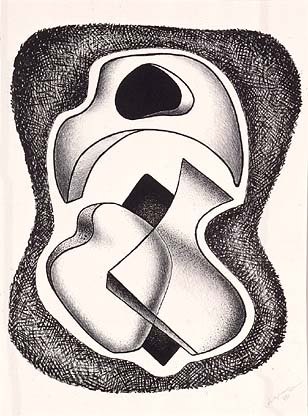
Le Rendez-Vous des Quatre Formes, from the portfolio Les Formes Vivantes
1963, lithograph on paper
Smithsonian Museum of Art
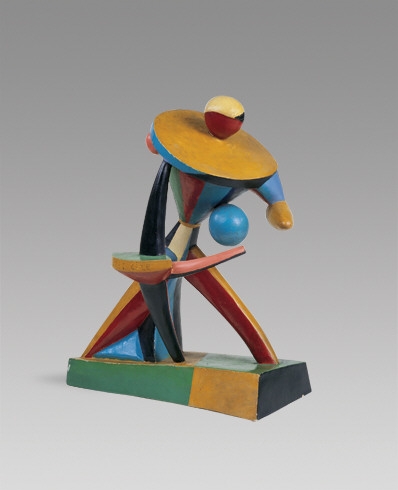
Carrousel Pierrot
1913, Painted plaster 24 x 19 1/8 x 13 3/8 inches (61 x 48.6 x 34 cm)
Guggenheim Museum, New York
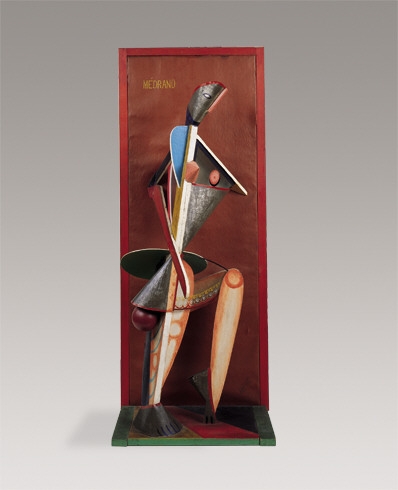
1913–14, Painted tin, wood, glass, and painted oil cloth, 49 7/8 x 20 1/4 x 12 1/2 inches (126.6 x 51.5 x 31.7 cm)
Solomon R. Guggenheim Museum, New York
Alexander Archipenko was a Ukrainian artist of the avant-garde movement. Archipenko was born in Kiev, during a time in which it was a part of the Russian Empire. In 1902 Archipenko enrolled at the Kiev Art School (KKHU), and later studied under S. Svyatoslavsky.
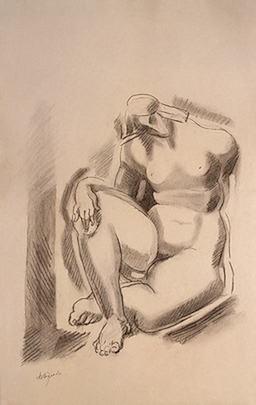
Seated Female Nude with Left Leg Bent
1920s, Pencil and black chalk, 49.9×31.8 cm
Hermitage Museum, Russia
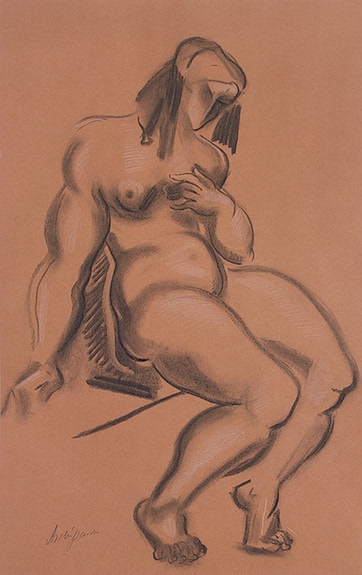
Seated Female Nude with Left Hand at Breast
Charcoal and white chalk on brownish-pink cardboard, 50.1×32 cm
Hermitage Museum, Russia
In 1906, Archipenko moved to Moscow, where there were more opportunities to exhibit and meet other artists. After only a few years in Moscow, Archipenko moved to Paris to join “Colony La Ruche” a popular artist’s colony. Archipenko was in the company of other Russian artists, including Nathan Altman and Sonia Delaunay-Terk. Colony La Ruche helped Archipenko forge his way into the Parisian art scene, and exhibit in the Salon des Independants and the Salon d’Automne. Archipenko showed alongside Pablo Picasso, Georges Braque and Andre Derain.
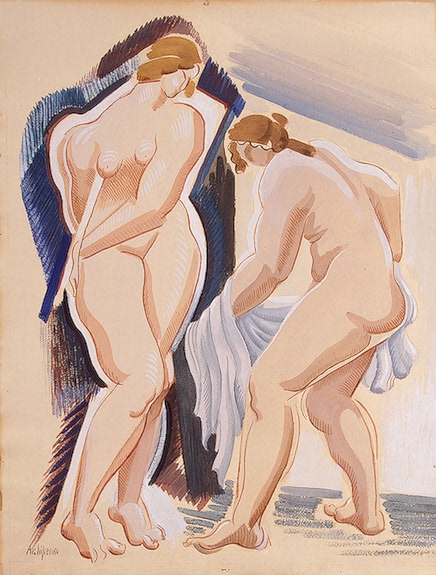
Two Nude Female Figures with a Cloth
Watercolour and gouache over pencil sketch on cream cardboard, 57.5×43.7 cm
Hermitage Museum, Russia
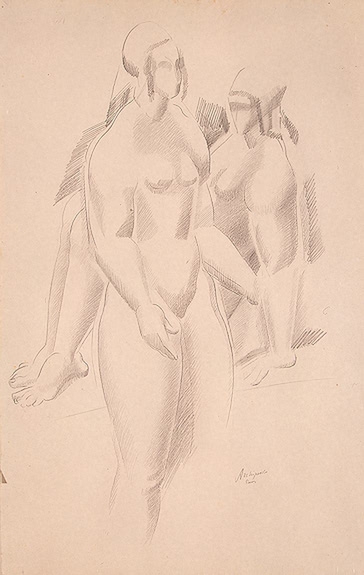
Two Nude Female Figures (Standing and Seated)
1920s, Pencil on paper, 49.8×31.8 cm
Russia Hermitage Museum, Russia
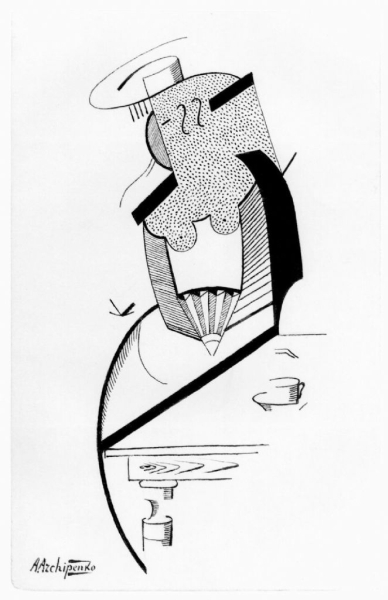
Study for “In the Cafe”
1915, pen & ink on paper, 8 1/8 X 5 1/4 in (20.7 X 13.3 cm)
Archipenko had his first solo show in 1912 at the Museum Folkwang in Hagen, and the next year he exhibited in the New York Armory Show. Archipenko moved to Nice for a short time before settling in Berlin, where he opened his own art school. In 1922 Archipenko showed his work in an important exhibition for Russian artists, along with Kazimir Malevich, El Lissitzky and Solomon Nikritin.
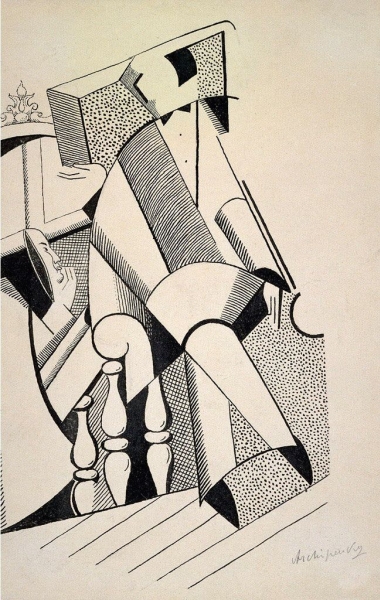
Movers/Verso: Untitled
1918-20, Ink on Paper, 21.9 x 13.9 cm
Hirshhorn Museum
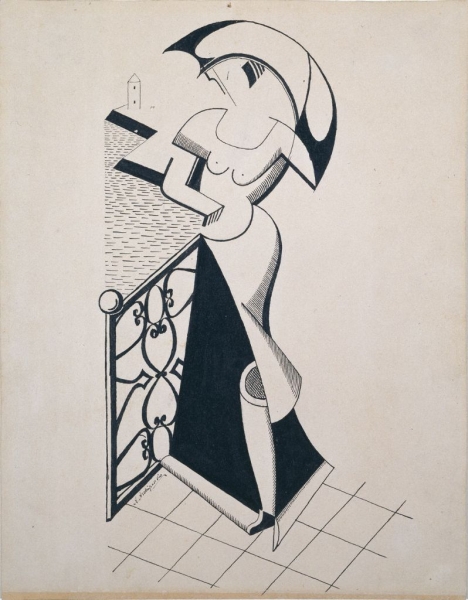
Woman with Umbrella
Pen and ink on paperboard, 27.1 x 21.2 cm
Hirshhorn Museum
In 1923 Archipenko left Berlin and moved to New York. After becoming a citizen of the United States in 1929, Archipenko was selected to exhibit in the Ukrainian pavilion at the World’s Fair in Chicago.
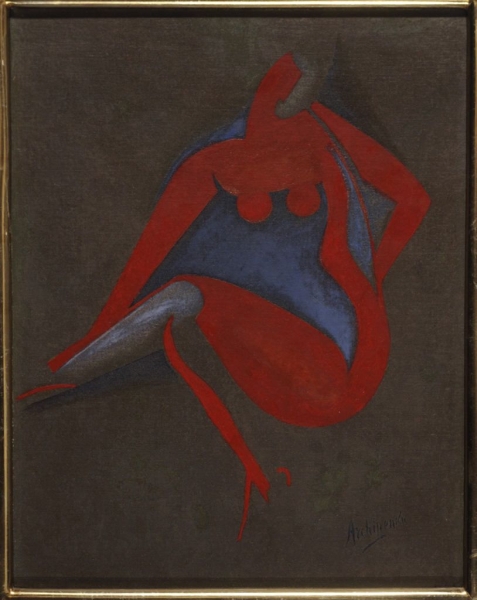
Seated Nude
1919-20, Oil on Canvas, 32.3 x 25.1 cm
Hirshhorn Museum
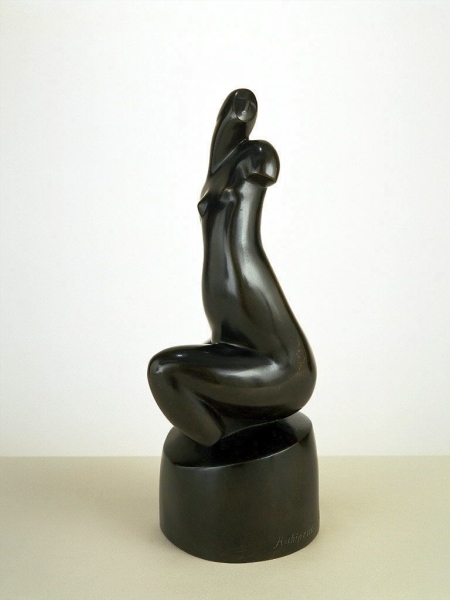
Seated Female Nude
1909-11, Bronze cast (1926), 13.2 x 15.1 cm
Hirshhorn Museum
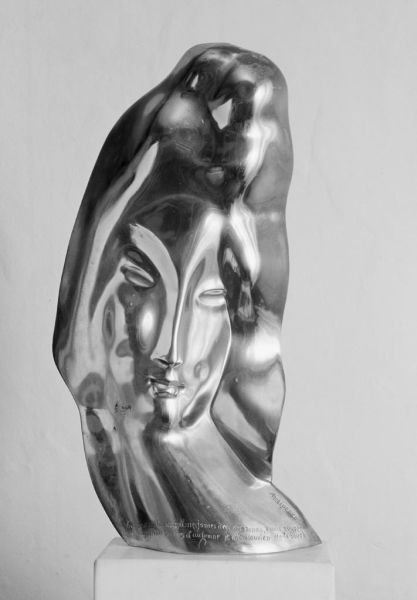
The Past
1926, Gilded metal, 34.8 x 18.7 x 6.4 cm
Hirshhorn Museum
Throughout the 1930s Archipenko continued to exhibit throughout Europe and the United States. Archipenko is known for his contributions to cubism, and for creating a new form of ‘sculpto-paintings’, which offered a new range of materials and methods of construction. Archipenko’s work is now in important collections internationally.
